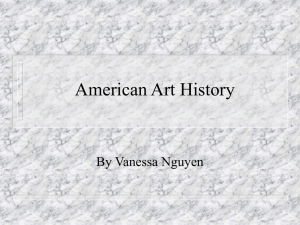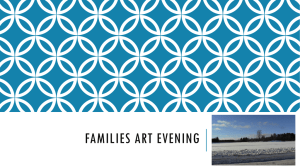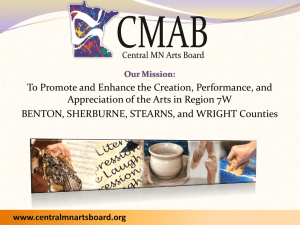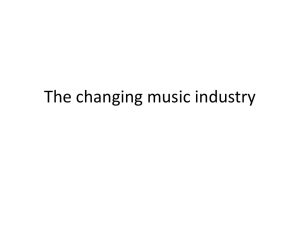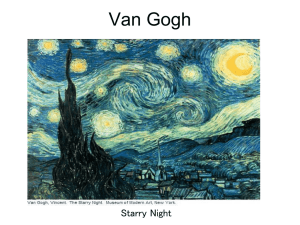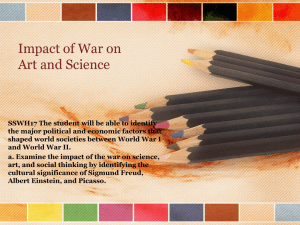American Art 1920-1940
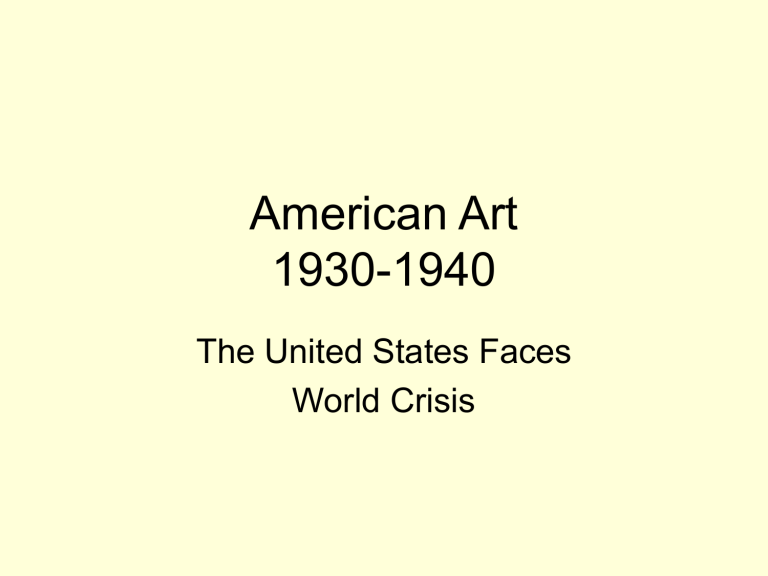
American Art
1930-1940
The United States Faces
World Crisis
The only thing we have to fear, is fear itself.
-FDR’s first inaugural address, 1933
The Roaring 20s
• Women gain right to vote (1920)
• Prohibition (1920)
• Lenin’s death (1924)
• Lindbergh flies across
Atlantic (1927)
• Stock Market Crash
(1929)
The Great Depression
Crisis and Response
• 1932- steel plants operating at 12 % capacity
• Writers saw book sales plummet 50 %
• Musicians had a 70 % unemployment rate
• 375,000 OK residents fled the Dust Bowl
• FDR’s NEW DEAL programs
New Deal and Art
• Works Progress
Administration set up
Federal Project #1
(1935)
• Four cultural projects: art, music, theatre, writing
• Artists placed in 8 divisions including murals, photographs, posters
Artists at Work
• 40,000 artists employed
• 3,350 public murals
• 41 % of WPA artists were women
• 33 % of WPA artists were from working class backgrounds
Paint America, but with your eyes open. Do not glorify Main Street.
Paint it as it is — mean, dirty, avaricious .
---Moses Soyer, 1935
Social Realism
What is Social Realism?
• In American art, also called, “American
Scene” or “WPA Art”
• Artists motivated by social causes and issues facing
Americans during the Depression
Social Realism
• Want art that is widely understood, accessible.
• Based on everyday life, challenges,
“telling it like it is” philosophy.
• Documented what
Depression was doing to people.
Reginald Marsh (1898-1954)
• Born in Paris to
American artists
• 1920 moved to New
York studied with
Kenneth H. Miller
• Primarily an illustrator before turning to painting full time
• Taught at the Art
Students League up to his death
Chatham Square
Reginald Marsh
• Marsh liked to portray people in crowds- what makes city life unique
• Saw self as a “reporter” but not a social/moral commentator
• After talking to Benton, started to use egg tempera, used here.
• Central figure collaged on (from another painting)
Philip Evergood (1901-1973)
• Educated in
England despite NY birth
• 1923- Art Students
League in NYC, studied with George
Luks, back to
Europe
• Settled in NYC in
1931
Evergood, the social protest painter
• Known for unpleasant subjects
• Bringing to light injustice in world
• Integrated black people and white people into his works
Raphael Soyer (1899-1987)
• Twin brother to Moses
Soyer, oldest of 6 children
• Soyers and brother
Isaac all studied art at
Cooper Union & Nat’l
Academy of Design
• Raphael taught at Art
Students League
(1930s-40s)
Soyer in the Studio
• Never mixed his politics with his painting
• Wanted to show subjects as humans, not propaganda pieces
Transients , 1936
Transients , 1936
I asked a group of [homeless men] to come to my studio to pose for a painting, which I eventually called
Transients…It was amazing. They were all sitting there and I thought to myself that I have created my own mission house.
More about the Painting
• Man in front leans toward the viewer wanting to ask for help, jacket doesn’t fit him
• Man to the right is sleeping, holding crutches; man behind him yawning is
Soyer
• Walter Broe makes direct eye contact with viewer, hold his Stetson in his hand
Thomas Hart Benton (1889-1975)
• One of the 3 great
Regionalist painters of the era
• Showing USA in positive terms
• Influenced by
European avantgarde art
• Was a teacher
More on Benton
• Wished to portray rural Americans doing what he thought of as typically American activities
• Tended to make inflammatory, sometimes contradictory, statements
Romance , 1931-32
Benton Working on Murals
Size and Scope
Stuart Davis (1892-1964)
• Had testy relationship with TH Benton
• Was part of the NY art scene and was involved in leftist politics
• Organized the Artists’
Congress of 1936
Davis the Activist
• Had been active in promoting NY artists as important as
American Scene
(Regionalists)
• First Amer Artists’
Congress spoke out against fascism, war, and racism.
I think that is the reason why dictatorships fear artists. They fear them because they fear free criticism. They rightly believe that if the forces represented by the artist are allowed to exercise their will, they will disrupt the Fascist regime.
--- Lewis Mumford, noted urban historian and outspoken critic of Totalitarianism
Lawn and Sky, 1931
Gloucester Harbor
Lawn and Sky
Arthur Dove (1880-1946)
• Early US modernist
• Worked as a commercial illustrator and often struggled financially but was friends with Stieglitz
Went to Europe in
1907-09, discovered
Fauves, other avantgarde movements
Good Breeze , 1931
Dove
• Similar to Kandinsky but used nature as an inspiration, especially sounds and sensations
• According to The Concise Oxford Dictionary of Art and Artists, “in 1910 [he] painted the first abstract pictures in American art.”
• First one-man show Stieglitz’s 291 Gallery in
1912
• By 1940s, experimenting with geometric abstraction.
• Fought to win artists royalty rights for reproduction of their work
The Zorachs
• William Zorach (1887-1966)
• Marguerite Thompson Zorach (1887-1968)
• William born in Lithuania and is primarily remembered as a sculptor
• Marguerite was one of the US’s leading modernist painters right before and immediately after the Armory Show
• Both exhibited in the Armory Show
Rites of Spring, 1909
What is American Art?
• The time and period where American artists were defining what is American art.
• Opens door for
Abstract
Expressionism, Pop
Bibliography
•
Virgil Baker, From Realism to Reality in Recent American Painting , 1959.
• David Bjelajac, American Art: A cultural History , 2000.
• Milton Brown, American Painting from the Armory Show to the Depression ,
1955.
•
Annette Carlozzi and Kelly Baum, eds. Blanton Museum of Art: American Art since 1900 , 2006.
• Ian Chilvers, The Concise Oxford Dictionary of Art and Artists , 1996.
• Wes Craven, American Art : History and Culture , 1994.
•
Erika Doss, Twentieth Century American Art , 2002.
• Nancy Frazier, The Penguin Concise Dictionary of Art History , 2001.
• Patricia Hills, Social Concerns and Urban Realism: American Painting of the
1930s , 1983.
•
R. Douglas Hurt and Mary K. Dains, eds. Thomas Hart Benton: Artist, Writer, and Intellectual , 1989.
• Karen Wilkin, Stuart Davis in Gloucester , 1999.
